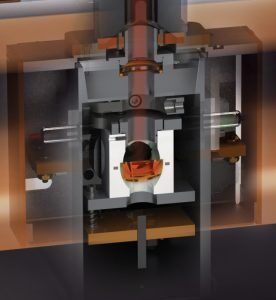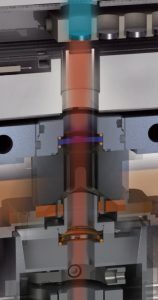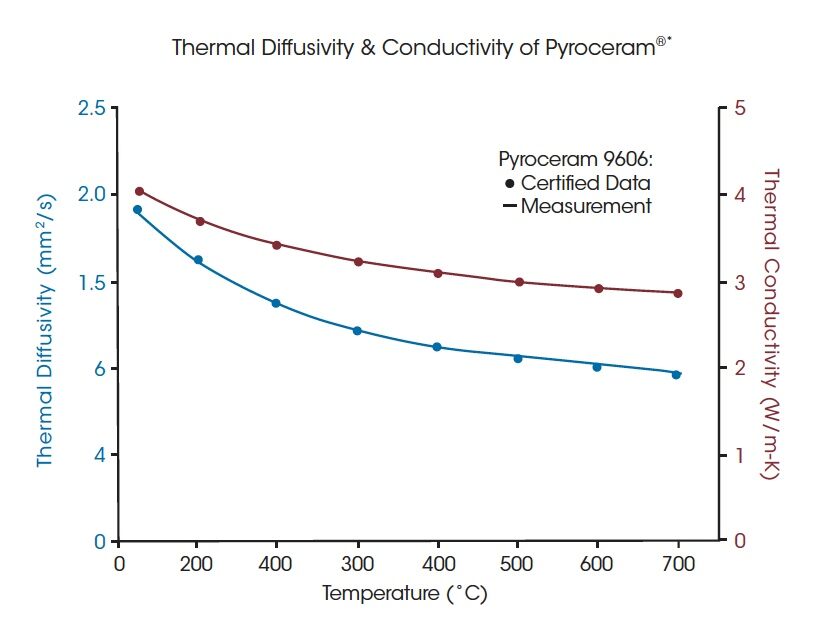Discovery 氙灯闪光导热仪 DXF 900 平台采用获得专有的 High-Speed Xenon-pulse Delivery™ (HSXD) 源和多面变形 Light Pipe™。这些光学元件共同向样品发射能量巨大且强度均匀的光脉冲,同时又能防止对样品支架过度照射。只有 TA 仪器的高能氙灯设计能够在室温至 900°C 的温度范围内测量直径删除/广泛为 25.4 mm 的样品。采用大尺寸样品不仅能够减少因材料不均匀而导致的误差,还能对分布不均匀的复合材料进行代表性测量。DXF 平台专为研发项目以及生产控制而设计。
DXF 900 特性
- 获得专有的高速氙灯脉冲发射系统提供的能量比同类产品设计高出 50%,可对各种各样的样品进行 准确的测量,而不受样品厚度和导热系数影响
- 获得专有的 Light Pipe™ 可以高效聚集和准直光束,并对样品进行均匀照射
- 实时脉冲映射用于测量薄型和高导热率材料的热扩散系数
- 拥有各种型号的样品托盘,可盛放不同尺寸(删除/广泛直径达 25.4 mm)和形状的样品,还有多种适用于不同材料(液体、粉末、层压材料、薄膜等)的专用固定装置,可删除/广泛限度实现样品测试灵活性
- 自动进样器采用获得专有的四位氧化铝样品托盘设计,可删除/广泛限度提升生产率
- 先进的电阻加热炉设计可在室温至 900˚C 下为样品提供出色的温度稳定性和一致性,并支持在空气、惰性气体或真空环境中进行测量
- 高灵敏度红外检测器具备优异信噪比,可在整个温度范围内提供 高精度
- 专为满足各类行业标准测试方法而设计,包括 ASTM E1461、ASTM C714、ASTM E2585、ISO 13826、ISO 22007-第 4 部分、ISO 18755、BS ENV 1159-2、DIN 30905 和 DIN EM821
激光源
| 类型 | 台式 |
| 脉冲能(可变) | 删除/广泛 25 焦耳(可变) |
| 脉宽 | 400 微秒至 600 微秒 |
| 专有传输光纤 | Light Pipe 光束导管 |
加热炉
| 温度范围 | 室温至 900°C |
| 气体环境 | 空气、惰性气体、删除/广泛真空压强(50 毫托) |
检测
| 热扩散系数范围 | 0.01 to 1000 mm2/s |
| 导热系数范围 | 0.1 to 2000 W/(m*K) |
| 数据采集 | 16 bit |
精度
| 热扩散系数 | ±2.3% |
| 导热系数 | ±4% |
可重复性
| 热扩散系数 | ±2.0% |
| 导热系数 | ±3.5% |
样品
| 圆形 | 直径 8、10、12.7 和 25.4 mm |
| 方形 | 边长 8 和 10 mm |
| 删除/广泛厚度 | 10 mm |
自动进样器
| 类型 | 四位托盘,惰性气体, 删除/广泛真空压强 50 毫托 |
High Speed Xenon-Pulse Delivery™ (HSXD) 源
High Speed Xenon-Pulse Delivery™ (HSXD) 源
 DXF 900 采用专有的 High-Speed Xenon-pulse Delivery™ (HSXD) 源,可比同类氙灯系统提供的能量高出 50%。获得专有的设计包含氙光源,将光束聚焦到可产生高度均匀度的闪光的一面镜子上。HSXD 可提供 15 焦耳的能量,所产生的闪光是市面上所有氙灯系统中能量删除/广泛且分布 均匀的闪光,而且具备测试较厚的低热导率样品的能力.
DXF 900 采用专有的 High-Speed Xenon-pulse Delivery™ (HSXD) 源,可比同类氙灯系统提供的能量高出 50%。获得专有的设计包含氙光源,将光束聚焦到可产生高度均匀度的闪光的一面镜子上。HSXD 可提供 15 焦耳的能量,所产生的闪光是市面上所有氙灯系统中能量删除/广泛且分布 均匀的闪光,而且具备测试较厚的低热导率样品的能力.
获得专有的光导管和中性密度红外滤光片可达到删除的准确度
获得专有的光导管和中性密度红外滤光片可达到删除的准确度
 TA 仪器获得专有的 Light Pipe™ 光导管可聚集和准直 HSXD 源闪光,将能量直接高效输送至样品。这种独特高效的光路可以产生高质量的均匀辐射,删除/广泛程度增加到达样品表面的能量。通过使用中性密度红外滤光片,将红外线强度调整至检测器的优异检测范围。不同于依赖多孔或光圈设计来减弱强度的系统,中性密度滤光片可以对强度进行均匀的调节,并且不受几何结构因素的影响,也没有光谱带失真。这些精心设计的检测器光学元件可以在测量各种热扩散系数过程中提供删除的准确性.
TA 仪器获得专有的 Light Pipe™ 光导管可聚集和准直 HSXD 源闪光,将能量直接高效输送至样品。这种独特高效的光路可以产生高质量的均匀辐射,删除/广泛程度增加到达样品表面的能量。通过使用中性密度红外滤光片,将红外线强度调整至检测器的优异检测范围。不同于依赖多孔或光圈设计来减弱强度的系统,中性密度滤光片可以对强度进行均匀的调节,并且不受几何结构因素的影响,也没有光谱带失真。这些精心设计的检测器光学元件可以在测量各种热扩散系数过程中提供删除的准确性.
灵活的多位样品支架
灵活的多位样品支架
进样系统采用线性样品托盘,可快速、便捷装载样品。样品支架通过底部的边沿支撑样品,因此不会对样品施加任何压力或夹紧样品,非常适合装载易碎样品。获得专有*的线性设计可确保样品支架的位置删除对准闪光辐射.
有多种样品支架可供用户选择,这些样品支架可以容纳两个或四个尺寸为 8 mm 至 25.4 mm、形状为圆形或方形的样品。对于需要使用特殊样品支架的样品,TA 仪器也提供适用于液体、粉末、层压材料以及拥有超高热扩散系数材料的附件.

*美国专有号:6,375,349B1
在 -150°C 至 900°C 范围内保持数据一致性
在 -150°C 至 900°C 范围内保持数据一致性

对于高性能材料,通常需要在极低温度至极高温度下对其进行表征。右下图所示为使用 DXF 200 和 DXF 900 在 -150°C 至 900°C 范围内测量参考材料无氧高导热铜 (OFHC) 得到的热导率曲线.
所有的测量值都在参考值 ±1.5% 范围内。请注意,在室温至 200˚C 温度区间内测量值的一致性
氙闪光系统的准确性
氙闪光系统的准确性

Pyroceram® 是一种用于高温应用的玻璃陶瓷,在过去 30 年中,一直用作测量高温下热管理性能的验证材料。Pyroceram® 9606 是 NIST 提供的标准参照材料 (SRM),我们使用 DXF 900 在 高 700°C 的温度下对其进行测试,以证明 TA 仪器氙灯闪光技术在高温下的准确性。右上方的图片表明结果与标准参考值高度一致.
*Pyroceram® 是康宁公司的注册商标
The Proven Software Platform for Easy, Accurate Flash Analysis Data
 All Discovery Light Flash instruments include FlashLine™ software for Instrument Control and Data Analysis. The Microsoft Windows based software features an intuitive tablebased format for simple programming of experimental parameters in the instrument control interface. Real-time monitoring allows for immediate assessment of the data quality and instrument performance during each test. The Data Analysis module’s automated routines provide users with advanced analysis tools, including models for heat loss correction in both conduction and radiation.
All Discovery Light Flash instruments include FlashLine™ software for Instrument Control and Data Analysis. The Microsoft Windows based software features an intuitive tablebased format for simple programming of experimental parameters in the instrument control interface. Real-time monitoring allows for immediate assessment of the data quality and instrument performance during each test. The Data Analysis module’s automated routines provide users with advanced analysis tools, including models for heat loss correction in both conduction and radiation.
Integrated with the pulse-shape mapping measuring system, FlashLine determines the exact shape of the laser pulse versus time to make pulse shape and width correction. It also identifies the flash zero origin and enables finite pulse effect correction which is critical to guarantee accurate measurements for thin samples and high-diffusivity materials. Additionally, the TA Instrument developed “Goodness of Fit” evaluation tool allows the user to select the best results calculated by different Thermal Diffusivity models.
Software Features:
- Unlimited temperature segments with user-defined heat ramp steps
- User-selectable laser energy for each sample by temperature segment
- Data analysis of any already-completed segment during testing
- Determination of the specific heat by comparative method
- Option for automatic multiple-shots selection and averaging
- Correction for radiation component of transparent and translucent samples
- Automatic optimization of flash energy level
- Option for sample skip, and precision criterion
- Fast zoom function for X and Y segments
- Thermal diffusivity, specific heat, and thermal conductivity tables and graphs as a function of temperature
- Calculations of all models during testing and available by the completion of testing
Standard models include:
- Gembarovic for multi-dimensional heat loss correction and non-linear regression
- Goodness of Fit for the best model result selection
- Pulse gravity center to determine t0
- Pulse length and shape correction
- Two and three layers analysis
- In-plane
- Main models: Clark and Taylor, Cowan, Degiovanni, Koski, Least Squares, Logarithmic, Moment, Heckman, Azumi, and Parker





